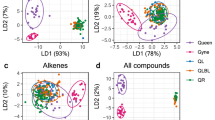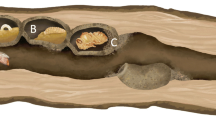Abstract
The cephalic labial glands are well developed in many bee species. In bumble bee males, they cover most of the head volume, and their secretion is used in marking reproductive territories and attracting virgin queens. In females, however, they are poorly studied. Here, we present chemical analyses of their secretion in queens and workers of Bombus terrestris under various social conditions. The secretion revealed a context-dependent composition with sterile females possessing large amounts of fatty acid dodecyl esters, ranging from dodecyl hexanoate to dodecyl oleate, compared to small amounts in fertile females. Significant reduction in the dodecyl esters also was found in queens at the competition phase, where worker reproduction, aggression, and gyne differentiation occur. The exclusive production of esters by sterile individuals also is typical of Dufour’s gland secretion in this species, albeit in this case these are octyl rather than dodecyl esters, and the differences between sterile and fertile individuals are qualitative rather than quantitative. We propose that the labial gland esters provide yet another signal of reproductive inactivity. In virgin queens, it may signal that egg laying is deferred to the next season, while in workers it reinforces the message “I am sterile and out of the reproductive competition”. Whether the reduction in dodecyl esters in fertile queens as a function of colony social development is involved in regulating gyne production and the onset of the competition phase is yet to be deciphered.







Similar content being viewed by others
References
Alaux C, Jaisson P, Hefetz A (2005) Reproductive decision-making in semelparous colonies of the bumblebee Bombus terrestris. Behav Ecol Sociobiol 59(2):270–277. doi:10.1007/s00265-005-0035-6
Alaux C, Jaisson P, Hefetz A (2006) Regulation of worker reproduction in bumblebees (Bombus terrestris): workers eavesdrop on a queen signal. Behav Ecol Sociobiol 60(3):439–446. doi:10.1007/s00265-006-0184-2
Amsalem E, Hefetz A (2010) The appeasement effect of sterility signaling in dominance contests among Bombus terrestris workers. Behav Ecol Sociobiol 64(10):1685–1694. doi:10.1007/s00265-010-0982-4
Amsalem E, Hefetz A (2011) The effect of group size on the interplay between dominance and reproduction in Bombus terrestris. PLoS One 6(3):e18238. doi:10.1371/journal.pone.0018238
Amsalem E, Twele R, Francke W, Hefetz A (2009) Reproductive competition in the bumble-bee Bombus terrestris: do workers advertise sterility? Proc Biol Sci 276(1660):1295–1304. doi:10.1098/rspb.2008.1688
Amsalem E, Shpigler H, Bloch G, Hefetz A (2013) Dufour’s gland secretion, sterility and foraging behavior: Correlated behavior traits in bumblebee workers. J Insect Physiol 59(12):1250–1255. doi:10.1016/j.jinsphys.2013.09.007
Ayasse M, Jarau S (2014) Chemical ecology of bumble bees. Annu Rev Entomol 59(1):299–319. doi:10.1146/annurev-ento-011613-161949
Barth FG, Hrncir M, Jarau S (2008) Signals and cues in the recruitment behavior of stingless bees (Meliponini). J Comp Physiol A Neuroethol Sens Neural Behav Physiol 194(4):313–327. doi:10.1007/s00359-008-0321-7
Bergman P, Bergström G (1997) Scent marking, scent origin, and species specificity in male premating behavior of two Scandinavian bumblebees. J Chem Ecol 23(5):1235–1251. doi:10.1023/B:Joec.0000006461.69512.33
Bertsch A, Schweer H, Titze A (2008) Chemistry of the cephalic labial gland secretions of male bombus morrisoni and B. Rufocinctus, two North American bumblebee males with perching behavior. J Chem Ecol 34(10):1268–1274. doi:10.1007/s10886-008-9538-8
Bloch G, Hefetz A (1999a) Reevaluation of the role of mandibular glands in regulation of reproduction in bumblebee colonies. J Chem Ecol 25(4):881–896. doi:10.1023/A:1020805103379
Bloch G, Hefetz A (1999b) Regulation of reproduction by dominant workers in bumblebee (Bombus terrestris) queenright colonies. Behav Ecol Sociobiol 45(2):125–135. doi:10.1007/s002650050546
Bloch G, Borst DW, Huang ZY, Robinson GE, Hefetz A (1996) Effects of social conditions on Juvenile Hormone mediated reproductive development in Bombus terrestris workers. Physiol Entomol 21(4):257–267. doi:10.1111/j.1365-3032.1996.tb00863.x
Bourke AFG (1994) Worker matricide in social bee and wasps. J Theor Biol 167:283–292
Calam DH (1969) Species and Sex-specific compounds from heads of male bumblebees (bombus spp). Nature 221(5183):856. doi:10.1038/221856a0
Cnaani J, Borst DW, Huang ZY, Robinson GE, Hefetz A (1997) Caste determination in bombus terrestris: differences in development and rates of JH biosynthesis between queen and worker larvae. J Insect Physiol 43(4):373–381. doi:10.1016/S0022-1910(96)00106-0
Cnaani J, Robinson GE, Bloch G, Borst D, Hefetz A (2000) The effect of queen-worker conflict on caste determination in the bumblebee Bombus terrestris. Behav Ecol Sociobiol 47(5):346–352. doi:10.1007/s002650050675
Coppée A, Mathy T, Cammaerts M-C, Verheggen FJ, Terzo M, Iserbyt S, Valterová I, Rasmont P (2011) Age-dependent attractivity of males’ sexual pheromones in Bombus terrestris (L.) [Hymenoptera, Apidae]. Chemoecology 21(2):75–82. doi:10.1007/s00049-011-0070-x
Cruz-Landim CD, Mello MLS (1967) The post-embryonic changes in Melipona quadrifasciata anthidioides Lep. (Hymenoptera, Apoidea). II. Development of the salivary glands system. J Morphol 123:481–502
Duchateau MJ, Velthuis HHW (1988) Development and reproductive strategies in Bombus terrestris colonies. Behavior 107:186–207
Francke W, Lübke G, Schroder W, Reckziegel A, Imperatriz-Fonseca V, Kleinert A, Engels E, Hartfelder K, Radtke R, Engels W (2000) Identification of oxygen containing volatiles in cephalic secretions of workers of Brazilian stingless bees. J Braz Chem Soc 11(6):562–571. doi:10.1590/S0103-50532000000600003
Hefetz A, Taghizadeh T, Francke W (1996) The exocrinology of the queen bumble bee Bombus terrestris (Hymenoptera: Apidae, Bombini). Z Naturforsch C: Biosci 51:409–422
Jarau S, Hrncir M, Zucchi R, Barth FG (2004) A stingless bee uses labial gland secretions for scent trail communication (Trigona recursa Smith 1863). J Comp Physiol A Neuroethol Sens Neural Behav Physiol 190(3):233–239. doi:10.1007/s00359-003-0489-9
Jarau S, Schulz CM, Hrncir M, Francke W, Zucchi R, Barth FG, Ayasse M (2006) Hexyl decanoate, the first trail pheromone compound identified in a stingless bee, Trigona recursa. J Chem Ecol 32(7):1555–1564. doi:10.1007/s10886-006-9069-0
Jarau S, Dambacher J, Twele R, Aguilar I, Francke W, Ayasse M (2010a) The trail pheromone of a stingless bee, Trigona corvina (Hymenoptera, Apidae, Meliponini), varies between populations. Chem Senses 35(7):593–601. doi:10.1093/chemse/bjq057
Jarau S, van Veen JW, Twele R, Reichle C, Gonzales EH, Aguilar I, Francke W, Ayasse M (2010b) Workers make the queens in melipona bees: identification of geraniol as a caste determining compound from labial glands of nurse bees. J Chem Ecol 36(6):565–569. doi:10.1007/s10886-010-9793-3
Katzav-Gozansky T, Soroker V, Ionescu A, Robinson GE, Hefetz A (2001) Task-related chemical analysis of labial gland volatile secretion in worker honeybees (Apis mellifera ligustica). J Chem Ecol 27(5):919–926
Keller L, Nonacs P (1993) The role of queen pheromone in social insects: queen control or queen signal? Anim Behav 45:787–794
Kocher SD, Grozinger CM (2011) Cooperation, conflict, and the evolution of queen pheromones. J Chem Ecol 37(11):1263–1275. doi:10.1007/s10886-011-0036-z
Krieger GM, Duchateau MJ, Van Doorn A, Ibarra F, Francke W, Ayasse M (2006) Identification of queen sex pheromone components of the bumblebee Bombus terrestris. J Chem Ecol 32(2):453–471. doi:10.1007/s10886-005-9013-8
Kubo R, Ono M (2010) Comparative analysis of volatile components from labial glands of male Japanese bumblebees (Bombus spp.). Entomol Sci 13(2):167–173. doi:10.1111/j.1479-8298.2010.00375.x
Kubo T, Sasaki M, Nakamura J, Sasagawa H, Ohashi K, Takeuchi H, Natori S (1996) Change in the expression of hypopharyngeal-gland proteins of the worker honeybees (Apis mellifera L) with age and/or role. J Biochem 119(2):291–295
Kullenberg B, Bergström G, Ställberg-Stenhagen S (1970) Volatile components of the cephalic marking secretion of male bumble bees. Acta Chem Scand 24(4):1481–1485
Le Conte Y, Hefetz A (2008) Primer pheromones in social hymenoptera. Annu Rev Entomol 53:523–542. doi:10.1146/annurev.ento.52.110405.091434
Lopez-Vaamonde C, Koning JW, Jordan WC, Bourke AFG (2003) No evidence that reproductive bumblebee workers reduce the production of new queens. Anim Behav 66:577–584. doi:10.1006/anbe.2003.2205
Michener CD (1974) The social behavior of the bees. Harvard University Press, Cambridge
Poiani SB, Da Cruz-Landim C (2010a) Changes in the size of cephalic salivary glands of Apis mellifera and Scaptotrigona postica (Hymenoptera: Apidae) queens and workers in different life phases. Zoologia 27(6):961–964. doi:10.1590/S1984-46702010000600018
Poiani SB, Da Cruz-Landim C (2010b) Morphological changes in the cephalic salivary glands of females and males of Apis mellifera and Scaptotrigona postica (Hymenoptera, Apidae). J Biosci 35(2):249–255
Rottler AM, Schultz S, Ayasse M (2013) Wax lipids signal nest identity in bumblebee colonies. J Chem Ecol. doi:10.1007/s10886-012-0229-0
Schmitt U, Bertsch A (1990) Do foraging bumblebees scent mark food sources and does it matter. Oecologia 82(1):137–144. doi:10.1007/Bf00318545
Simpson J (1960) The functions of the salivary glands of Apis mellifera. J Insect Physiol 4(2):107. doi:10.1016/0022-1910(60)90073-1
Simpson J, Riedel IBM, Wilding N (1968) Invertase in the hypopharyngeal gland of the honeybee. J Apic Res 7:29–36
Sobotnik J, Kalinova B, Cahlikova L, Weyda F, Ptacek V, Valterova I (2008) Age-dependent changes in structure and function of the male labial gland in Bombus terrestris. J Insect Physiol 54(1):204–214. doi:10.1016/j.jinsphys.2007.09.003
Stangler ES, Jarau S, Hrncir M, Zucchi R, Ayasse M (2009) Identification of trail pheromone compounds from the labial glands of the stingless bee Geotrigona mombuca. Chemoecology 19(1):13–19. doi:10.1007/s00049-009-0003-0
Urbanova K, Cahlikova L, Hovorka O, Ptacek V, Valterova I (2008) Age-dependent changes in the chemistry of exocrine glands of Bombus terrestris queens. J Chem Ecol 34(4):458–466. doi:10.1007/s10886-008-9456-9
Van Doorn A (1986) Investigations into the regulation of dominance behavior and of the division of labor in bumblebee colonies Bombus-terrestris. Neth J Zool 37(3–4):255–276
Van Doorn A, Heringa J (1986) The ontogeny of a dominance hierarchy in colonies of the bumblebee Bombus terrestris (Hymenoptera, Apidae). Insect Soc 33:3–25
Van Honk CGJ, Hogeweg P (1981) The ontogeny of the social structure in a captive Bombus terrestris colony. Behav Ecol Sociobiol 9:111–119
Van Honk CGJ, Velthuis H, Röseler PF (1978) Sex-pheromone from mandibular glands in bumblebee queens. Experientia 34(7):838–839
Van Honk CGJ, Velthuis HHW, Roseler PF, Malotaux ME (1980) The mandibular glands of Bombus terrestris queens as a source of queen pheromone. Entomol Exp Et Appl 28:191–198
Van Oystaeyen A, Oliveira RC, Holman L, van Zweden JS, Romero C, Oi CA, D’Ettorre P, Khalesi M, Billen J, Wackers F, Millar JG, Wenseleers T (2014) Conserved class of queen pheromones stops social insect workers from reproducing. Science 343(6168):287–290. doi:10.1126/science.1244899
Wilms J, Eltz T (2008) Foraging scent marks of bumblebees: footprint cues rather than pheromone signals. Naturwissenschaften 95(2):149–153. doi:10.1007/s00114-007-0298-z
Winston ML, Slessor KN (1992) The essence of royalty - honey-Bee queen pheromone. Am Sci 80(4):374–385
Zacek P, Kalinova B, Sobotnik J, Hovorka O, Ptacek V, Coppee A, Verheggen F, Valterová I (2009) Comparison of age-dependent quantitative changes in the male labial gland secretion of Bombus terrestris and Bombus lucorum. J Chem Ecol 35(6):698–705. doi:10.1007/s10886-009-9650-4
Acknowledgments
The work was supported by a grant from The Israel Science Foundation founded by the Israel Academy of Sciences (ISF grant no. 535/08)
Author information
Authors and Affiliations
Corresponding author
Electronic supplementary material
Below is the link to the electronic supplementary material.
Figure S1
(DOCX 27 kb)
Rights and permissions
About this article
Cite this article
Amsalem, E., Kiefer, J., Schulz, S. et al. The Effect of Caste and Reproductive State on the Chemistry of the Cephalic Labial Glands Secretion of Bombus Terrestris . J Chem Ecol 40, 900–912 (2014). https://doi.org/10.1007/s10886-014-0484-3
Received:
Revised:
Accepted:
Published:
Issue Date:
DOI: https://doi.org/10.1007/s10886-014-0484-3




